Menu

“The greatest threat to our planet is the belief that someone else will save it.” – Robert Swan
Climate change is a big challenge for global farming. It’s key to adapt by using crops that can handle stress. These strong plants help keep productivity high. They are especially important for places where it only rains a bit often and is managed by smaller farms. It’s very important to use sustainable farming methods that include dealing with climate change.
Unusual weather can harm normal farming a lot. That’s why we are going to talk about how special plants can help. These plants are good at growing even when the weather is not normal. They play a big part in making sure we have enough food, even as the climate changes a lot.
Agriculture is facing big challenges because of climate change. High levels of carbon dioxide (CO2) trap heat, making the Earth warmer. Farming has become very different over time. The temperature has increased by 1.07 °C when we compare data from 1850–1900 to 2010–2019. This change has also made rainfall and weather events more unpredictable.
It’s vital to find ways for crops to survive these new conditions. The United Nations supports climate-smart agriculture to help. This means making farms more productive, building their resilience to climate change, and reducing harm to the environment. Climate-resilient crops are a key part of these efforts. They are specially bred to grow well under stress.
These crops are key to keeping our food supply stable. They can still produce good harvests even when the weather is bad. While high CO2 can improve crop yields in some places, it often lowers the quality. Resilient crops can handle many kinds of stress at the same time. This is great news for farmers, especially those in poorer countries. Studies show that plants can adjust quickly to a changing environment.
Global food security is at risk because of climate change. Using resilient crops is important to keep food production steady. Without them, staple crop yields might drop by 30%. It shows why sustainable farming is crucial. Nearly 53% of studies say social factors can influence the use of these crops. Many studies have looked into what helps farmers in poorer places use these resilient plants over the past thirty years.
In sum, climate-resilient crops are critical for steady food production. They’re key to keep up global food security. Supporting these crops is essential in the fight against climate change. It ensures farmers around the world can feed their communities.
Farmers, especially the small ones, are worried about how climate change affects their crops. They rely on rain and old ways of farming. It’s important to adapt to these changes to avoid big losses. Different people act differently to cope, like based on their gender, age, if they’re married, and their ethnic background.
It has been found that the amount of main crops could fall by almost a third because of climate change. This makes it even more urgent to adapt. But, not all farmers have started to use new, stronger crop types. This makes them even more at risk.
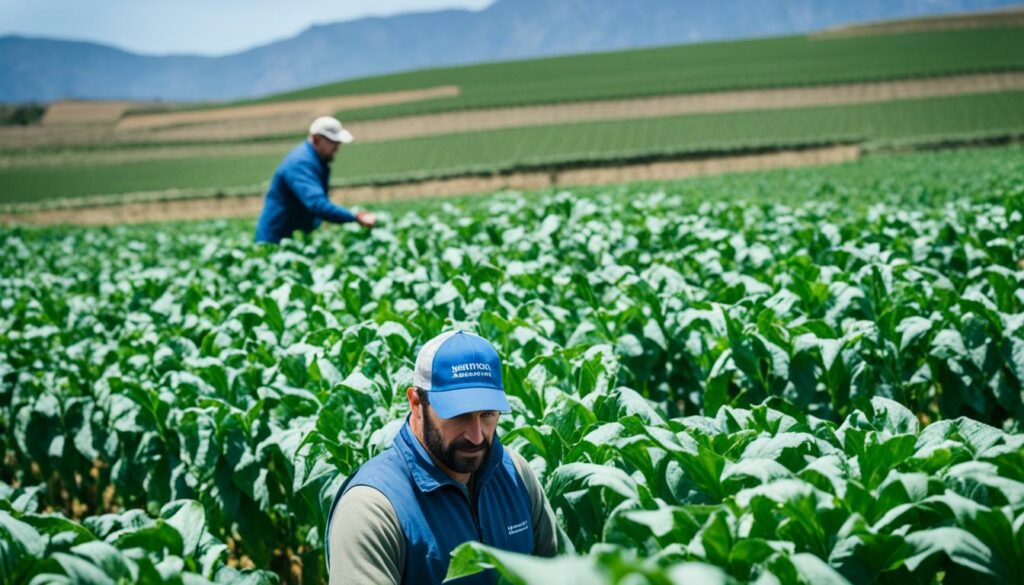
Places with many small farmers are at big risk, especially in the countryside. The best crops are the ones that can handle not having much water and use it well. This is key for surviving droughts, high temperatures, and floods.
How much farmers know, their access to things they need, and how much money they have play a big role in whether they use these crops. They might need to change how and when they plant. Changing to these tougher crops helps them deal with climate changes better.
To wrap up, using stronger crops is crucial for small farmers’ future. It can increase their income and make sure they have enough food. Tackling these issues head-on can really make a difference for communities living in the countryside.
Climate-resilient crops help tackle the challenges brought by climate change. They are crucial for dealing with the many stresses that come with it. These varieties of crops are aimed at meeting farming needs effectively.
The key aspect of climate-resilient agriculture is drought tolerance. Varieties of maize and sorghum can survive long periods without water. They ensure growth and yield remain stable in low-rain areas. This is vital for places dependent on rain for farming. Their use has shown to reduce the impacts of dry periods, securing food for many.
As temperatures rise worldwide, crops that can handle heat are more important. The development of crops like the Tutti apple helps in hot, dry regions. These varieties keep producing food reliably, protecting farmers in hot areas.
Flooding, made worse by climate change, is a big threat to farming. Crops have been developed to survive being underwater for a brief period. The flood-resistant rice by the IRRI, for instance, can improve yield by 1 to 3 tons. This is key in areas prone to flooding, helping maintain food supply.
| Trait | Example | Region | Impact |
|---|---|---|---|
| Drought-Resistant Crops | Drought-Tolerant Maize | Sub-Saharan Africa | Improved yield stability and food security |
| Heat-Tolerant Varieties | Tutti Apple | Spain | Consistent productivity in high temperatures |
| Flood-Resistant Crops | Flood-Resistant Rice | Asia | Resilience to flooding, maintaining yield |
Climate-resilient farming helps farmers deal with a changing climate. It uses crops that can stand up to droughts, heat, floods, and salt. This approach brings more than just stable crop yields.
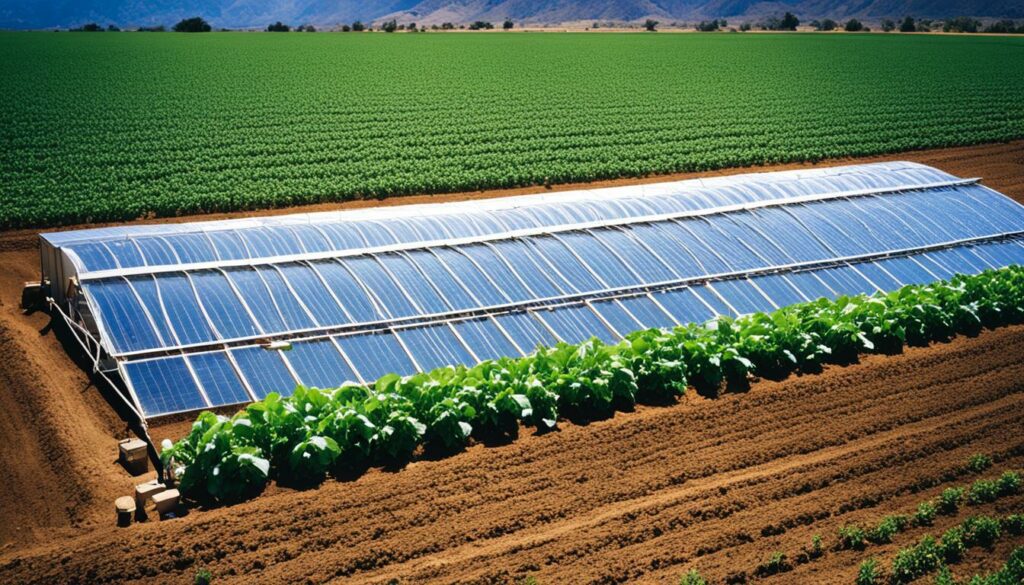
Adopting resilient farming boosts productivity straight away. This method creates crops tough enough to grow well in any weather. That means even with bad weather, farms can keep producing food.
In North Carolina, farms like Against the Grain and Blackwell’s Farm made more money thanks to special farming covers and less tilling. These changes show how smarter farming can mean bigger pay-offs.
Resilient farming helps farmers stay economically strong. It makes their crops more steady and reliable in the face of changing weather. For example, in North Carolina, using special covers and tilling less led to more money each year.
This extra money in North Carolina, as found in a report on resilient farming, shows the financial upsides for farmers. By making their income more reliable, farmers can cope better with changes in the weather.
| Farm | Practice | Annual Income Increase |
|---|---|---|
| Against the Grain | High Tunnels | $13,000 |
| Blackwell’s Farm | Cover Crops | $238 |
| Blackwell’s Farm | Reduced Tillage | $437 |
| New Ground Farm | High Tunnels | $9,365 |
| New Ground Farm | Cover Crops | $27 from half-acre field |
Using climate-resilient techniques is more than maintaining farm output. It’s a strong method to secure and grow farming communities’ economies. It supports stability and strengthens farm life worldwide.
Many things influence whether farmers choose climate-resilient crops. Acevedo et al. (2020) looked at 30 years of research. They found out what helps and what stops small farmers in poorer countries from choosing these crops.
Good extension services are key to promoting climate-smart farming. They help farmers learn new methods and about strong crop types. In 202 papers we analysed, it’s clear that well-organised extension services help share knowledge. This knowledge is vital for changing how farmers work. But, only 53% of these studies said these services really consider people’s different backgrounds, like age or sex.
Getting the right seeds and fertilisers can change everything for farmers shifting to resilient crops. Most farmers want seeds that can cope with drought and use water well. But, many still don’t switch to these crops because they can’t get these seeds easily. Making sure farmers know how to get the right seeds is very important for progress.
How much farmers know really matters when it comes to picking climate-resilient crops. The studies we looked at say that the more farmers know (their education level), the more they pick up useful farming methods. Education helps farmers see climate change coming and make smart choices about their crops. It’s surprising that only 202 out of 886 articles we first checked talked about how crucial farmer education is. This shows we really need to put more focus on it.
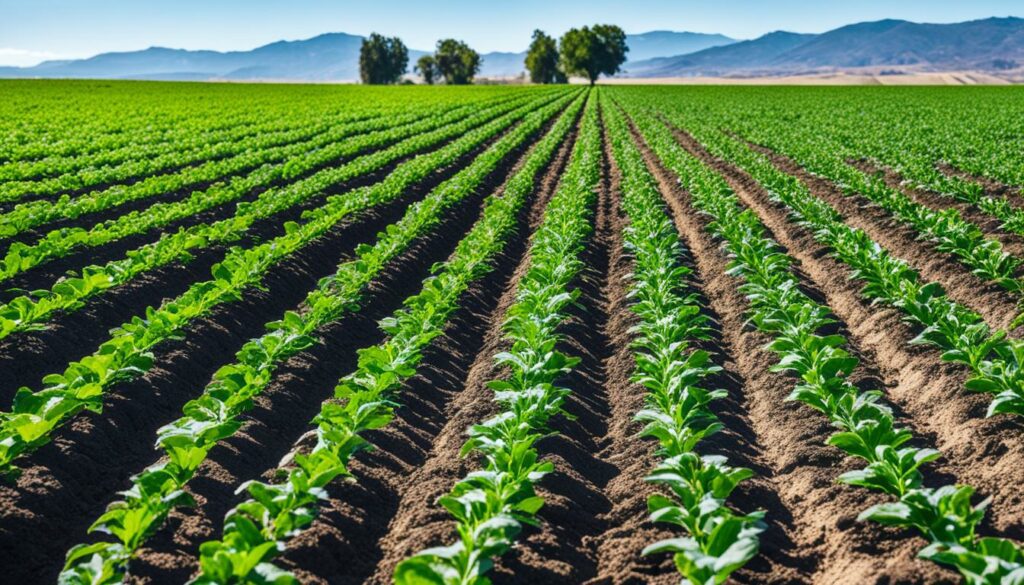
As we focus more on keeping farms sustainable, we must use new ways of farming. This includes climate-resilient agricultural practices and high-tech sustainable farming methods. These help us deal with changes in climate.
For example, we’re using new ways to water our crops like drip systems and gathering rainwater. This saves water and keeps our plants healthy, even when the weather is uncertain. It’s part of the big plan for sustainable farming methods.
Looking forward, farmers are breeding new kinds of crops that can handle extreme heat and cold. More and more farmers are choosing these tough plants. They help keep farms productive, even when the weather is hard.
The government is also doing its bit. It gives money to farmers during bad weather and helps study tough crops. In the United States, the NRCS helps farmers with money and advice. This is to get more climate-resilient crops growing.
Getting the weather right is key for farmers. They use the latest in weather predictions to plan their days. Having good, personalised forecasts helps a lot.
Learning about new techniques is always important, too. Farms and groups have workshops to teach farmers about smart farming. This helps them make good choices.
Farmers working together, both close to home and around the world, makes a big difference. They share tips on how to handle different climates. This teamwork helps everyone be more sustainable.
Things like conserving the land, switching crops, and using plant covers help the earth. They make the soil better, store more carbon, and use less water. New tech, like tractors that follow maps and drones, also helps. It makes farming smarter and more efficient.
| Techniques | Benefits |
|---|---|
| Drip Irrigation | Efficient water management |
| Crop Breeding | Development of resilient varieties |
| Weather Forecasting | Informed decision-making |
| Workshops & Training | Innovation & knowledge sharing |
| Conservation Tillage | Improved soil health |
| Precision Agriculture | Resource optimisation |
Technology has greatly improved farming when it comes to the climate. Modern tools help farmers work smarter. By using precise tools and data, they can use resources better and choose wisely.
Precision farming is changing how we use resources. With help from GPS and sensors, farmers boost their productivity. They can use water, fertilisers, and pesticides more efficiently. This saves resources and boosts the harvest. For instance, smart irrigation systems like Cascade can cut down water use by 7%. The OSCAR robot can save a lot more – it uses 10% less water, needs 80% less time, and cuts down on energy by 20%.
Remote sensors are key for smart farming. Satellites and drones keep an eye on fields and give updates on crops, soil, and weather. This helps farmers act quickly and wisely. Such timely actions are crucial as we aim to feed almost 10 billion by 2050.
This tech not only improves harvests but also helps protect farms against climate problems. For example, in 2021, the CropWatch programme was launched to aid Asian and African countries using satellite data. It shows how powerful data strategies are in the fight against climate change in farming.
| Program | Region | Funding (USD) | Focus |
|---|---|---|---|
| Food Systems Resilience Program (FSRP) | Eastern and Southern Africa | 621 million | Resilience Building |
| China Green Agricultural and Rural Revitalization Program | China | 345 million | Sustainable Practices |
| Punjab Resilient and Inclusive Agriculture Transformation Project (PRIAT) | Pakistan | 200 million | Inclusive Development |
| Agriculture Resilience, Value Chain Development, and Innovation (ARDI) program | Various Countries | 125 million | Innovation in Farming |
Thanks to technology, farming is becoming more efficient and sustainable. Precision and data-driven farming are leading us to a bright future in agriculture.
In the world today, the climate can change quickly. So, farmers are using new methods to grow stronger crops. From Africa’s rich soil to Asia’s varied lands, these special plants are making a big difference.
In Africa, tough maize plants are helping farmers grow more. They’ve increased their harvest by 23% with these special seeds. 67% of them are now better at coping with a changing climate. This has not only boosted their food but also their money, with a 27% income rise in some places.
New seeds and farming ways have made a huge difference. They’ve helped crops better adjust to their environment by up to 65%.
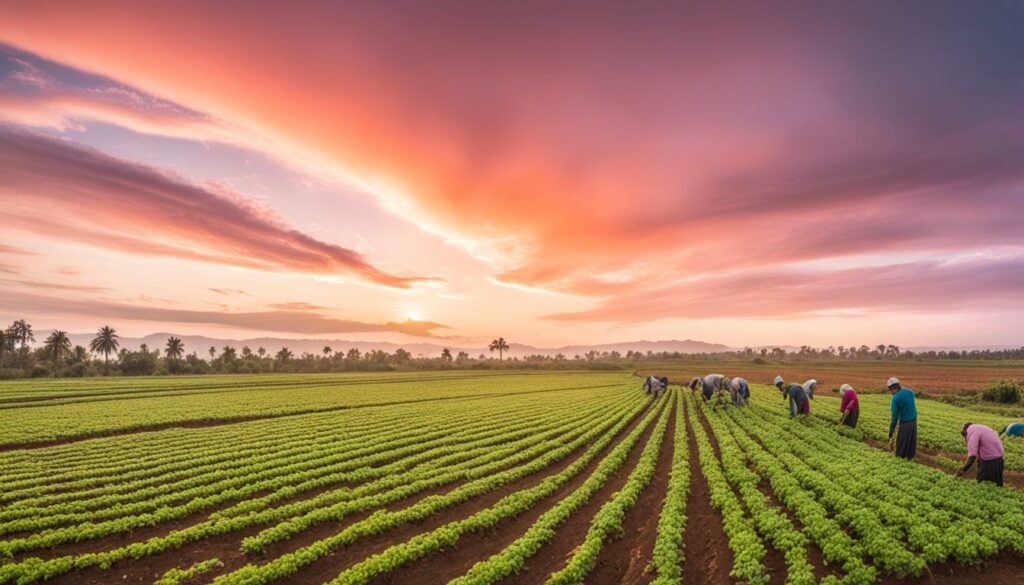
Asia’s farmers are also finding ways to beat the changing weather. For example, in Nepal, many are keeping special seeds safe for planting. In Bangladesh, a lot of money goes to making their farms tougher against climate change. Now, most of their rice fields are ready for any weather.
Here’s a quick look at the differences these efforts are making:
| Region | Key Strategy | Outcome |
|---|---|---|
| Sub-Saharan Africa | Drought-tolerant maize adoption | 23% increase in maize production |
| Sub-Saharan Africa | Multiple climate-smart practices | 67% farmers increased resilience |
| South Asia | Community seed banks in Nepal | 88% contribution to climate adaptation |
| South Asia | Implementation of BCCSAP in Bangladesh | Significant portion of rice cropping areas covered |
These examples show how important it is for farmers to adapt. Their methods are making farming stronger and more secure. This is key for the future as our climate keeps changing.
A strong policy base is key in promoting agriculture that stands up to climate change. Governments back resilient farming with helpful rules and laws. For instance, the Agriculture Resilience Act in the U.S. is boosting our food and farming areas. It’s doing this through things like crop insurance, organic farming, and testing new farming techniques.
These policies are even more important with a growing global population. We’ll need to feed about 9.7 billion people by 2050. So, supporting resilient agriculture is crucial.
In America, the government is supporting eco-friendly farming through laws like the Inflation Reduction Act. This law provides funds for climate-friendly farming and agricultural projects. It helps cut down on greenhouse gas emissions by offering support through programmes like EQIP and CSP.
Considering the big impact on the environment, the agriculture and food industry needs more financial help. Only a small part of the climate money goes to agriculture, showing we need more investment. The World Bank’s stepping up, offering nearly $3 billion each year for Climate-Smart Agriculture, sets a great example.
The World Bank is backing actions to meet the Paris Agreement’s targets. This includes supporting agriculture that can withstand climate problems.
Americans from all sides of politics are worried about how the climate affects farming. So, they’re coming together to back initiatives like the Agriculture Resilience Act. This Act does more than just support farming. It also looks into climate studies and ways to reduce food waste. For example, the SARE programme under ARA plans to open new resilience centres and include more diverse voices in farming research, aiming to spend $150 million each year from 2024 to 2028.
Help from the government is crucial in fighting the economic and agricultural damage from climate change. For example, areas hit by seawater intrusion faced $427,000 in losses. By building up strong support systems, our food and agriculture can be more ready for climate challenges.
Using crops that can handle the changing climate is key for farming’s future. But, getting there comes with its own set of problems.
One big issue in farming is how social and economic differences affect farmers. Things like gender, age, and income matter a lot. They can make it hard to grow climate-resilient crops. Also, how much the farm owner knows and their access to things like seeds can make a big difference.
Studies over the past 30 years have shown that crops which can handle drought are the most popular. But not all farmers can easily start planting them. This is because of the social and economic walls they face. Getting the right help to these farmers is important so they can improve their farming methods.
Certain global issues make it hard for farmers to switch to better crops. Things like poor laws, lack of support, and fights over water cause big obstacles. The predicted drop in crop yields because of climate change doesn’t help, making these challenges even tougher.
Around 5,650 articles discussed these global problems. They showed how the world got 1.07°C warmer from 1850 to 2019. This makes farming even more difficult, with CO2 adding to the problem. Extreme weather is also getting more common, stressing farmers further.
To tackle these challenges, efforts in smart agriculture and crop improvement are crucial. It’s all about making farms stronger and smarter against the risks we face.
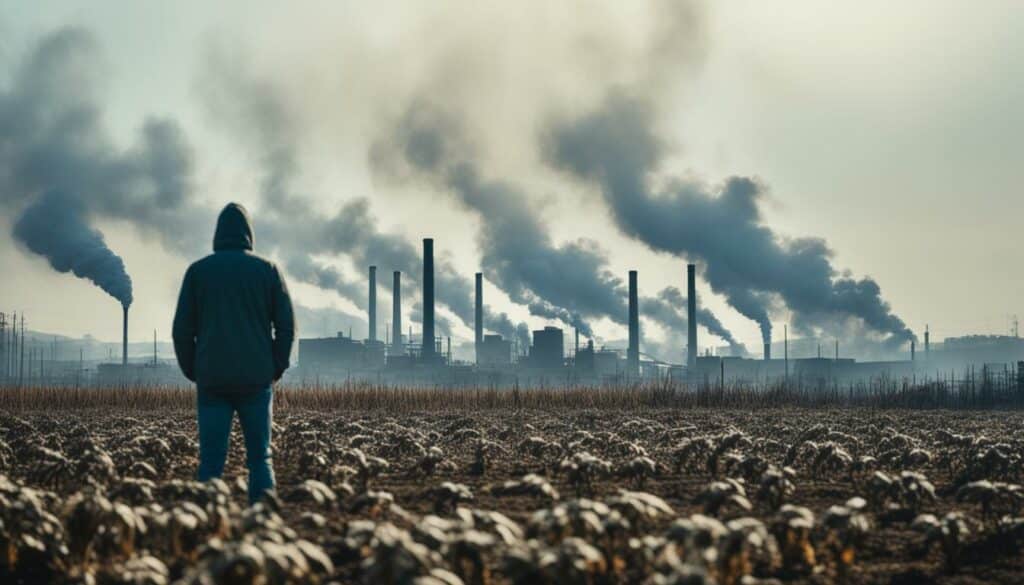
| Challenge Type | Factors | Impact |
|---|---|---|
| Socio-economic Barriers | Social differences, education levels, access to inputs | Varied adoption rates of resilient crops |
| Geopolitical Factors | Lack of governance, institutional support, water conflicts | Disruption in adoption of resilient practices |
Engaging with communities and sharing knowledge is key to encourage the use of climate-resilient crops. Farmer networks and initiatives at the community level are crucial. They help to spread the best ways to farm and give access to important resources like climate updates and technical expertise.
Through these networks, farmers can help each other face the challenges caused by climate change.
Mihir Bhatt, the director of the All India Disaster Mitigation Institute, talks about the need to evaluate and share experiences. This is from his work in tsunami relief and rehabilitation, and it can help farming communities deal with climate risks. Bhatt’s work shows how important it is to share knowledge in farming for successful adaptation.
In South Asia, half of the water used for urban and farming activities comes from underground. But as the groundwater decreases, there are big sustainability challenges. That’s why there’s a need to support farming methods that can handle these issues, with the help of farmer networks. These networks from cities like Delhi, Bangalore, and Dhaka share tips to overcome issues like air quality, lack of water, and rising sea levels.
2023 was the hottest year on record, and 2024 might be even hotter. So, there’s a big push to use community-based actions to adapt. These local movements help grow existing projects, like making cities greener and promoting conservation farming. Doing so doesn’t need new high-tech solutions but more of what we already know.
By working together, South Asia can lead in creating green jobs. These are jobs that help the environment and introduce new ways to capture carbon. Through community efforts and sharing knowledge, we can prepare farmers for a future where the climate is more unpredictable.
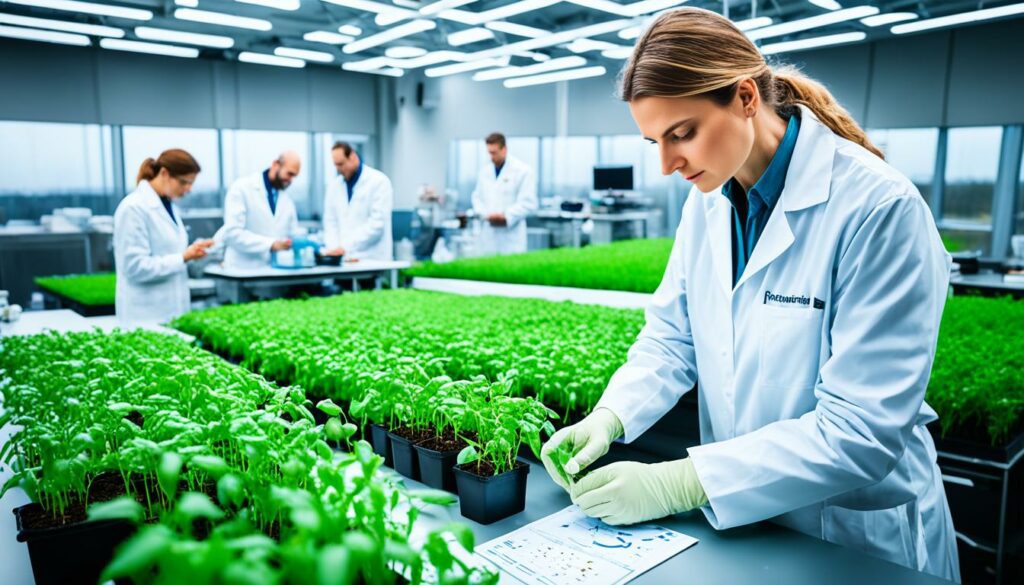
Climate-resilient crops offer hope in the face of climate change. They are designed to tackle growing environmental challenges. This is done by ensuring they can survive through various stresses.
Research into resilient crops is key to overcoming challenges. Scientists and farmers work to make crops that can handle drought, heat, and floods. They have found that making crops drought-resistant is particularly important.
Improving water-efficiency in crops helps them stay productive in tough conditions. This work is essential for the future of farming in a changing climate.
Using sustainable farming methods is vital. These methods aim to improve soil, save plants and animals, and use resources wisely. Such an approach supports not only crops but also the environment.
It helps ensure that we can keep farming in a way that is good for nature. This is crucial for the long-term availability of food.
| Statistics | Details |
|---|---|
| Global surface temperature increase | Approximately 1.07°C from 1850–1900 to 2010–2019 |
| Adoption of climate-resilient crops | Lower than expected in some cropping systems |
| Reduction in yields | Projected up to 30% in staple crops |
| Influence of social differences | About 53% of studies show factors like sex, age, marital status, and ethnicity affect adoption |
| Importance of extension services and education | Crucial for effective adoption of resilient crops |
Future research and sustainable farming are crucial for our food’s future. We need to innovate in farming and improve crops and techniques. These steps are essential to keep feeding our growing world in the face of climate change.
Our journey through climate-resilient crops shows how vital it is to improve resilience. The rate at which these crops are taken up varies among small-scale farmers. Their choices are influenced by different factors like sex, age, and ethnicity. These factors play a big part in how farmers in different areas deal with climate issues.
The world’s population is growing. More people are eating foods that use a lot of resources like meat and dairy. This puts a strain on our natural resources. At the same time, climate change could cut staple crop yields by nearly a third. It’s essential to farm in ways that are ready for these challenges. Threats from insects and fungi add even more pressure, making our work to protect food production crucial.
Recent advances in bioengineering, like pikobodies and genetic circuits for plants, give us hope. They show we can build crops that can fight off diseases. We must focus on creating sustainable agriculture. This requires new technologies, good policies, and local knowledge sharing. By working together, we can ensure there’s enough food for the future.
Climate-resilient crops can handle the bad impacts of climate change. This includes things like not having enough water, too much heat, floods, and salty soil. They help keep the amount of food steady, even when the weather is tough.
They’re important because they make growing food less risky. They make sure there’s enough to eat every year. This is especially good for places that rely a lot on the rain to grow their food.
They keep growing food even if the weather is really bad. This means there’s more food for everyone. It’s super important for countries with not a lot of money because they often have trouble getting enough food.
There are many types. Some can deal with not much water, others with a lot of heat, and some with floods. Each kind helps farmers get more food even if the weather is not great.
Small farmers are very at risk from big changes in the climate. They mostly use old ways to grow crops and need rain. When the weather is bad, they can lose their crops. This makes life very hard for them and their families.
It helps farmers grow more food and make sure their income stays steady. It’s also good for the land because it uses new ways that don’t hurt the environment. So, it’s better for everyone in the long run.
Things like farming advice, seeds, and education are very important. If farmers know how to use these new crops and ways to grow food, it makes a big difference. These things help them do well with the new types of crops.
There are many smart ways to farm that help the environment. These include doing things like planting at different times, using less water, and growing different crops together. They all help farmers deal with bad weather and not harm the earth.
New tech can show farmers the best ways to use their land and water. It helps them know what to do to get the most food without hurting the planet. This makes farming better for everyone.
Yes, some parts of Africa and Asia have found good ways to grow food that can handle the hard weather. Small farmers there now have more food and are better protected from the bad side of climate change.
By making good rules and helping out with money, governments can make farmers able to deal with bad weather. They also support finding new ways to grow food. This helps farmers do better and not worry so much about the weather.
Problems like not enough money, wars, and bad rules can make it hard for farmers to use these new ways of growing food. Solving these problems is important so that more farmers can grow food that’s good for the future.
When farmers work together and learn from each other, they can do more. Sharing what works helps everyone. Together, farmers can be stronger against the challenges of the changing climate.
There is a lot of work being done to make better crops and farming ways. By keeping on improving, we can face the new tests that the weather brings. All this work makes it easier for farmers to keep growing food for the planet.